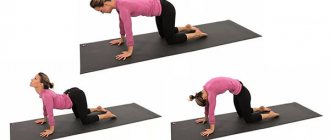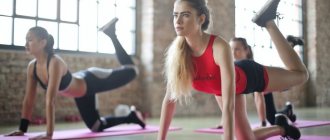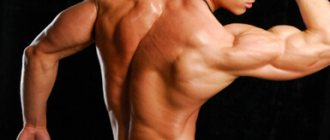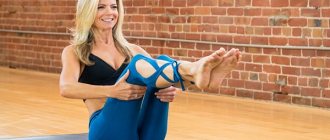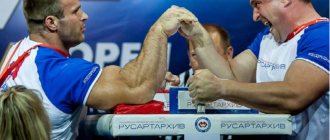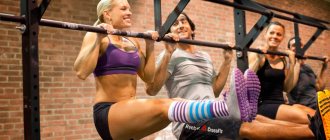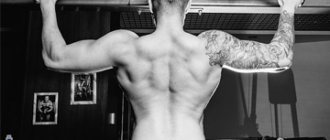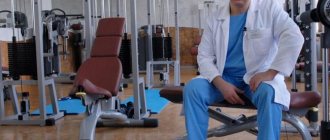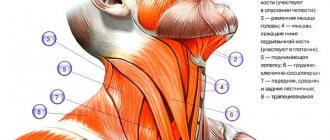Pilates was originally developed as a complex for recovery from injury. Now it is a full-fledged fitness practice.
Marina Kavkaeva
Pilates trainer, movement and body awareness specialist
Pilates is a whole philosophy.
As a method of working with movement, it is aimed primarily at deep muscles: Pilates turns on “sleeping” muscles and relaxes overstrained ones, thereby relieving stress from the joints, relieving pain and many diseases associated with improper functioning of the body.
As a method of working with the mind, it develops bodily awareness and teaches you to listen and hear your body.
Pilates also works with breathing, mobility (what is mistaken for stretching), stability and endurance.
We invite you to dive a little into this sport and train with model Daria Krasikova.
"A hundred"
This exercise is not suitable for those who are trying to get six-pack abs, but any beginner can do it. “The Hundred” is aimed at strengthening the muscles of the legs, arms, back and core, helping to reduce waist size and tighten the stomach.
During the exercise, try not to overstrain your neck or press it to your chest, also do not rush, do not swing your arms and do not lift your lower back from the floor.
Everyday stretching for beginners. Favorite exercises of actress Angelina Strechina
Technique:
- Lie on the floor so that your spine is pressed to the floor.
- Leave your legs bent on the floor or lift them up in the same position.
- Extend your arms straight and make five slow strokes while inhaling and exhaling.
- Swing your arms five times as you inhale and five as you exhale.
Do this exercise 50-100 times.
The most beneficial Pilates workout
Online Pilates for beginners at Motify varies depending on the instructor, goal, equipment, and duration. Choose an activity that best suits your home workout needs.
There are classes that teach you the basics, as well as workouts designed specifically to tone your muscles and get in shape. More advanced classes introduce dynamic stretching and build strength faster. We encourage you to familiarize yourself with the online workout before you begin. This way you can understand whether it is right for you and whether you are able to complete it to the end.
Either way, there is no one Pilates workout that is better than the rest. You can include a variety of lessons in your lesson plan and thus become familiar with all aspects of Pilates. As a result, in return for the effort you put into your training, you will get maximum results.
Gluteal bridge
This exercise not only corrects the volume and shape of the buttocks, but also strengthens the lower back, reducing pain, evenly distributing the load on the lumbar region, and also improves walking and running performance. In addition, its main advantage is its variability: you can perform it with your own weight, with a barbell or dumbbells, elastic bands, or with your leg raised up. During the exercise, do not forget about the straight position of the body.
Photo: istockphoto.com
Technique:
- Lie on your back with your legs bent and your heels firmly on the floor.
- Place your hands along your body.
- Lift your hips up as you exhale, hold for a second, lower as you inhale.
Do the exercise 10 times.
Pilates for beginners: where to start?
Unlike other, more energetic types of exercise, Pilates involves smooth movement, a special type of breathing and maximum concentration on the work of the target muscles. This is exactly what beginners often have difficulty with.
Therefore, the first step in Pilates should be to master the basic rules of the discipline (such as breathing patterns) and change movement habits. “The main task for beginners in Pilates is to restore the correct movement patterns anatomically,” says Anastasia Yurkova, master trainer of the X-Fit group programs in Russia.
Most of us have certain postural disorders and movement patterns developed on their basis (most often incorrect). We slouch, “lean” to one side, and sleep in approximately the same position. Pilates classes allow you to master more correct movement patterns and improve posture. But when mastering them, it is important to avoid automatism; you need to “teach” the body to move according to new patterns.
This is what Pilates exercises for beginners are aimed at. “Beginners need exercises that allow them to normalize and restore the pattern of movement in all planes. We are required to perform movements lying on our backs, on our stomachs, and to the side - this way we use all the main joints and directions of movement,” explains Anastasia Yurkova.
It is also important for beginners to master the neutral position of the spine. “We all have postural disorders, there are some habits in the way we sit, lie, skewed to one side, in hyperlordosis or stoop,” says Anastasia Yurkova. “This is not the correct anatomical position; there is no need to move in it.” This is dangerous for the musculoskeletal system. The first step is to teach the body this neutral position.”
Among the exercises recommended for beginners, experts especially highlight lightweight versions of the classic movements of the discipline. “These include “pelvic clock”, “hundred”, shoulder bridge, one leg circles, one leg stretch, exercises lying on the side and on the stomach, back rolls, saw, roll up-roll down, “pendulum”, lists Diana Ibragimova.
Glute bridge with leg raised
This is a more complicated variation of the previous exercise. It works the same muscle groups, but you have to put in more effort.
Technique:
- Lie on your back with your legs bent.
- Hands along the body.
- Raise your leg up as you exhale, hold for a second, lower as you inhale.
- Switch legs and repeat the exercise.
Perform the exercise eight times on each leg.
This complex is good because it targets the main muscle groups: back, core, buttocks, thighs. Very simple, but at the same time effective.
Marina Kavkaeva
Pilates trainer, movement and body awareness specialist
Pilates is all-round development of the body. It is useful for both athletes and beginners of different age categories. It is important to choose the right load level for yourself.
Why are home Pilates workouts so effective?
Pilates includes a variety of techniques. Some of them require special equipment, but there are many others that just require a flat surface, a mat and a pinch of motivation. These workouts are perfect for you if you want to get fit at home.
Online Pilates classes at home will teach you how to effectively achieve your cardio and strength training goals in a confined space. Each Pilates class begins with the instructor explaining the objectives of the workout and listing the equipment needed.
This way, you'll narrow down your choices and quickly figure out what's right for you.
Crunches
The crunch is a fundamental exercise aimed at developing the rectus abdominis muscle. This is what will help in creating the relief without requiring any additional equipment. However, this exercise will not help you lose weight, and if overloaded, it can cause back pain. There is no need to rush here either.
Photo: istockphoto.com
Technique:
- Lie on your back with your legs bent at a 90-degree angle.
- Place your hands behind the back of your head.
- Raise your shoulders and chest so that your lower back remains on the floor.
- Return to the starting position.
Do the exercise 30 times.
How to pump up your whole body? Circuit training from Lerchek
Advantages
Regular Pilates classes have undoubted benefits and allow you to achieve the following goals:
- improve the condition of muscles, strengthen them without increasing muscle mass, correct posture;
- train flexibility and stretching, restore joint function;
- stabilize the functioning of internal organs and the vestibular apparatus, improve coordination of movements;
- increase concentration and mental activity;
- relieve stress and take control of your psycho-emotional state.
Studios on the reformer in Moscow
To achieve high results, it is much more effective to practice Pilates on special medical simulators. They can significantly speed up rehabilitation, relieve pain of a neurological and orthopedic nature, make muscles more elastic and joints more flexible. When exercising on a reformer, the central muscle fibers are in constant tension, which makes it possible to thoroughly work them out.
This service is provided by:
- Republika;
- Pilates Class.
* The material is published as an advertisement.
How to choose a Pilates ring
Before purchasing, be sure to make sure that the handles are tightly fixed to the hoop and do not slip. Otherwise, you will not be able to perform most exercises well.
The second important point is the load created by the simulator. Rings are produced with varying degrees of resistance. This is necessary to reach athletes of all levels of development. If you are a beginner, ask your salesperson to select an isotonic ring with minimal resistance.
Popular models and approximate prices:
- Svarog SVYP-300 (700 RUR);
- StarFit FA-402 (700 RUR);
- Yamaguchi Ring Fit (RUR 1,900);
- Torres YL5004 (RUR 530);
- Fittools FT-Pilates-Ring (900 RUR);
- Atemi APR02 (700 RUR).
We recommend buying a Pilates ring in sports stores, where you can evaluate the quality of workmanship and get advice from the seller. Exercise machines can also be purchased on specialized websites or online trading platforms.
Basic principles
No other technique can activate the muscles, brain and breathing as much as Pilates. This fitness system has its own principles, which were once developed by the author of the method.
To achieve positive results, it is extremely important to comply with each of them:
- Correct breathing
A developed breathing algorithm is required when performing each exercise. You need to learn to adjust the pace of your classes to it, and not vice versa.
During the training, a special breathing technique is used. When you inhale, the chest expands and the intercostal muscles tighten. When exhaling, they completely relax.
With this breathing algorithm, the abdominal muscles do not work, so the shoulder joint and spine are stabilized.
- Concentration
It is important that each exercise is performed correctly, in strict accordance with the prescribed technique. Therefore, one of the goals of classes is gradual and complete mastery of it. Movements must be performed with utmost precision, taking into account individual physiology.
Before you start doing the exercise, you need to mentally do it in your head, focusing on the key points. You also need to maintain a high concentration of attention.
- Control of the power center
In the process of performing the exercises, the task is to learn to distinguish the muscles between the diaphragm and the pelvic floor, use them in a certain order and include them in any complex. This area is the power center. Controlling the strength center is important not only during exercise, but also in everyday life.
- Smoothness
This is one of the basic principles that helps maintain concentration and control over your own body. During each exercise, it is important to move slowly and very carefully.
Smooth execution of exercises allows you to receive moral and physical pleasure not after, but during the training.
Benefits and disadvantages of exercise
The benefit of the “hundred” is that this exercise is suitable for general physical training and beginners. It gradually strengthens the abdominal muscles and improves coordination of movements. Over time, a person who regularly performs the “hundred” will definitely cope with more complex tasks.
The advantages of the exercise are as follows:
- Helps tighten the stomach;
- Works not only the rectus abdominis muscle, but also the transverse ones, reducing waist size;
- Strengthens the muscles of the back, legs, arms, and core. This is especially true for beginners;
- Gives a small cardio load, increases heart rate, trains the heart.
For a tummy tuck, the 100 may be even more effective than a regular crunch. Throughout the exercise, the muscle remains toned, so performance can be high.
The downside of the exercise is that it cannot be complicated. At a certain point, just “hundreds” will not be enough, the athlete will hit a “plateau”, and progress will stop. But on the other hand, few people use Pilates movements as a way to “get a six-pack.” Usually the goals are different, and the level of exercise is completely sufficient for them. “Hundred” will help you recover after pregnancy, improve mobility, strengthen muscles, and start doing fitness if you haven’t practiced anything like that before and just worked in the office.
The Golden Hundred Exercise for Multiple Abdominal Muscles!
Pilates abdominal exercises
If you want a flat stomach and powerful abs, do Pilates 10 minutes a day and the results will not be long in coming. We have prepared for you a set of Pilates exercises for the abs and waist, inspired by the book “Pilates from A to Z” by Cynthia Weider.
Exercise 1
- We stand with our feet hip-width apart and slightly bent at the knees, our arms freely lowered and pressed to our hips.
- As you inhale, stretch up, raising your right arm, but without lifting your shoulder blades. The neck and shoulders are relaxed. At the end of the movement, turn the palm inward.
- As you exhale, we tense the muscles of the abdomen and pelvis. We stretch our hand up and diagonally to the left. While bending, the left hand slides along the thigh. Direct your gaze straight ahead. While exhaling, also stretch upward.
- Exhale, keeping your abs tense, and slowly return to the starting position. Repeat the exercise on the other side. The total number of repetitions is 10 times to the right and left.
Exercise 2
- We stand with our feet hip-width apart, arms straight in front of us at shoulder level. We stretch the top of our head up, breathe evenly, the abs and pelvis are tense.
- We rotate the body left and right through the starting position. The legs and pelvis are motionless.
- Repeat the exercise 12 times.
Exercise 3
- We lie on our backs, legs bent at the knees, feet hip-width apart, parallel and pressed tightly to the floor, arms placed freely along the body. The muscles of the pelvis and abdomen are tense.
- Take a deep breath, and as you exhale, lift your arms and upper body above the floor. Hold for 2 counts, reaching your arms forward, then return to the starting position. The pace of the exercise is smooth. The pelvis and lower back are pressed into the floor.
- Repeat the exercise 15 times.
Exercise 4
- The starting position is the same.
- Now, during the same lift as in the previous exercise, swing your arms back and forth. At the initial level - 20 swings, at intermediate and advanced levels - 50 and 100. Breathing: inhale - five swings, exhale - five swings.
Make the exercise more challenging by keeping your legs elevated as you lift. The smaller the angle of leg lift (from 45° to 60°), the more difficult it is to perform the movements, but both the lower and upper parts of the abs are worked more effectively.
Exercise 5
- Lying on your back, legs bent at the knees, feet hip-width apart. Take a deep breath.
- As you exhale, tighten your abdominal and pelvic muscles, then smoothly pull one leg bent at the knee toward your chest.
- Continuing to exhale, lift your other leg, bending it at the knee. As you exhale, lower your legs one by one in the reverse order.
- Repeat the exercise 10–12 times, alternating legs.
Exercise 6
- Sitting, legs are straightened and joined together, the front of the feet are extended forward as much as possible.
- As you inhale, stretch your crown upward, straightening and stretching your spine. Extend your arms in front of you at shoulder level, palms facing down, shoulder blades down.
- As you exhale, tensing your abdominal muscles, rotate your body to the right.
- Inhale, return to the starting position and stretch the top of your head up. As you exhale, twist your body to the left. Alternate turns right and left, a total of 12 times.
Exercise 7
- While sitting, clasp your knees with your hands and tilt your chin down.
- Inhale, and as you exhale, tighten your abs and pelvis.
- As you inhale, perform a smooth roll back to your shoulders. As you exhale, return to the starting position.
- Repeat the exercise 10 times.
Exercise 8
- While sitting, legs are straightened and connected, with straight arms at the back.
- Keeping your back straight, lift your legs up to an angle of 45° from the floor.
- Perform alternating circular movements with your legs to the right and left. Repeat the exercise 10–12 times. At advanced level up to 25.
Abdominal muscles work!
Exercise 9
- Sit up straight with your knees bent and your feet flat on the floor. Grasp your heels with your hands and lift your legs up, spreading them wide to the sides and straightening your knees. Hold for 5 inhalations and 5 deep exhalations.
- Repeat once. Pause and repeat the exercise 3-5 more times.
Exercise 10
- Lie on the floor, place the shin of your right leg on your left knee. Cross your arms behind your head. The shoulder blades are pressed to the floor. This is the starting position.
- Raise your body and try to touch your left elbow to your right knee.
The total number of repetitions is 20 times at the beginner level, up to 50 at intermediate and advanced levels.
Pulling the elbow to the opposite knee
Exercise
11
- Sit on your right thigh with your knees bent. Place your right hand on the floor at a distance of 15 cm from the body, do not bend your elbow.
- Inhale and push with your right hand, lifting your hips so your shoulder is directly above your wrist. At the same time, extend your left arm up. Your body should resemble the letter "T".
- As you exhale, turn your body down, lower your left hand, as if scooping up water under you. Inhale, return to the previous position and repeat the exercise 6-8 times. Then the same amount in the other direction.
The exercise can also be performed with your arm bent at the elbow.
Side plank crunch on elbow
Pilates. Slim stomach
Pilates for the waist is very effective. If you have chosen it as the most suitable technique for you, then remember a few rules:
- Exercise at least 2-3 times a week at the same time.
- Approach your studies comprehensively. Even if you choose Pilates to lose belly fat, pay attention to all muscle groups.
- Don’t stop when you notice the first result, but consolidate it with new workouts.
- Try different Pilates techniques.
- Pilates for the abdomen and sides should take you at least 10 minutes.
Pilates for the abdomen and sides video:
Conclusion
In the article, you learned how to prepare your abs before Pilates and how to most effectively get rid of belly and flank fat using this technique. We recommend that you read the article Pilates for Beginners to learn how to work other muscle groups using the Joseph Pilates method and learn even more about the technique.
What muscles work
The load falls on:
- Transverse, rectus and oblique abdominal muscles. These are the target muscles that provide lifting and twisting of the body;
- The front and rear deltas provide arm rotation. The triceps work statically, the biceps remain in an extended position;
- Sartorial muscle, quadriceps;
- Latissimus dorsi muscles when lifting;
- Chest for maintaining body position and stabilization.
